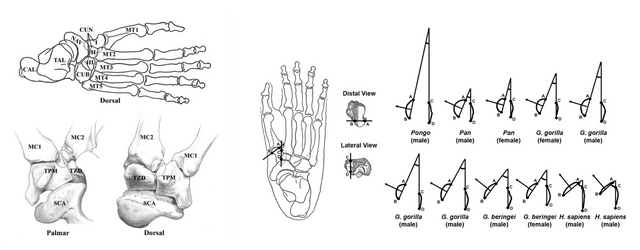Terrestrial adaptations in Gorilla beringei beringei
"Schultz (1927) noted differences in foot morphology between Pan, Gorilla, and Homo. The more arboreal lowland gorillas appear to resemble chimpanzees, whereas the terrestrial mountain gorilla is more similar to modern humans in overall morphology. "

Among gorillas, the mountain gorilla, Gorilla beringei beringei, is the least arboreal (Doran and Hunt, 1994; Remis, 1994, 1998). They live in high-altitude habitats, where fruit resources are scarce and their primary food source is terrestrial herbaceous vegetation, and travel and forage within their daily range almost exclusively terrestrially (Schaller, 1963; Groves, 1970, 1971; Tuttle, 1970; Fossey and Harcourt, 1977; Tuttle and Watts, 1985; Doran, 1996; Doran and McNeilage, 1998).
The hallux of mountain gorilla (Gorilla beringei beringei) is more adducted than other gorillas[1, 2], they have the second least divergent great toe, after humans, second lowest opposable great toe index.

Synapses
McHenry, H. M., & Jones, A. L. (2006). Hallucial convergence in early hominids. Journal of Human Evolution, 50(5), 534–539. https://doi.org/10.1016/j.jhevol.2005.12.008
Tocheri, M. W., Solhan, C. R., Orr, C. M., Femiani, J., Frohlich, B., Groves, C. P., … Jungers, W. L. (2011). Ecological divergence and medial cuneiform morphology in gorillas. Journal of Human Evolution, 60(2), 171–184. https://doi.org/10.1016/j.jhevol.2010.09.002
oh no, permissionless memes